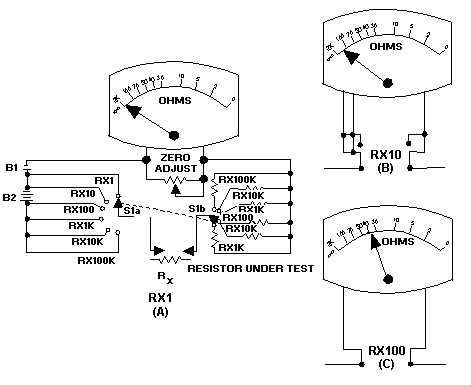3-20
Figure 3-14.—Ohmmeter with multiplication switch.
The range used to measure any particular unknown resistance (Rx in view A of figure 3-14) depends
on the approximate ohmic value of the unknown resistance. For instance, the ohmmeter scale of the figure
is calibrated in divisions from 0 to infinity. Note that the divisions are easier to read on the right-hand
portion of the scale than on the left. For this reason, if Rx is greater than 1,000 ohms and if you are using
the R 1 range, you will be unable to accurately read the indicated resistance. This happens because the
combined series resistance of resistors Rx is too large for range R 1 to allow enough battery current to
flow to deflect the pointer away from infinity. You need to turn the range switch to the R 10 position to
obtain the 1,000-ohm reading.
Let’s assume that you have changed the range switch to the R 10 position and the pointer now
deflects to a reading of 375 ohms, as shown in view B of figure 3-14. This would indicate to you that
unknown resistance Rx has 3,750 (375 times 10) ohms of resistance. The change of range caused the
deflection because resistor R 10 has only 1/10 the resistance of resistor R 1. Therefore, selecting the
smaller series resistance allowed a battery current of sufficient value to cause a readable pointer
deflection. If the R 100 range were used to measure the same 3,750 ohm resistor, the pointer would
deflect still further to the 37.5-ohm position, as shown in view C. This increased deflection would occur
because resistor R 100 has only 1/10 the resistance of resistor R 10.
Q-23. The R 100 resistance selection on an ohmmeter has what amount of resistance compared to the
R 10 selection?
The circuit arrangement in view A of figure 3-14 allows the same amount of current to flow through
the moving meter coil. The same amount is allowed to flow whether the meter measures 10,000 ohms on
the R 1 scale, 100,000 ohms on the R 10 scale, or 1,000,000 ohms on the R 100 scale.

